Sunday June 7, 1998. Four Members of AESS, Andrew, Bjorn, Brian, and Glenn drove to Monroe, WA to launch the clubs first rocket and payload package.
The four-hour trip from Portland, OR was a breeze. Our time was occupied by talk of rockets, sub atomic particles, radio antennas, and true sine wave inverters. The trip was cloudless and sunny much more favorable for a launch than the attempt two weeks earlier at Bend, OR.
Upon arrival we still had our work cut out for us. Due to a last minute design change of a dual recovery system we were short one parachute. A special thanks to Tomm for letting us borrow his 4ft Dai. chute. It didn't take long to set up the downlink for the video and data in the back of Andrew's Subaru. Within no time we were watching live pictures on a B&W t.v. as Glenn walked around with the payload section containing the camera.
One thing we learned from the launch was to come more prepared. Even after all the hours of work we put into the project there were still a dozen things we did not have. Fortunately Dave Davis, the Perfect for WA and general high power rocket guru had almost everything we were short. He was indispensable. He loaned us the 38mm rocket motor hardware and Stu B. oversaw the motor assembly. Those rocket guys sure are friendly.
Once the motor, recovery system, and payload were in place and functioning the rocket was moved out to the launch pad. Since this flight was also to get a level 2 certification through Tripoli ( National High Power Rocket Organization) we had to have the rocket inspected by a range safety officer and fill out a flight card describing the rocket.
Bjorn was on ground camera. Andrew and others took up positions at either end of the field to speed recovery, Glenn monitored at the downlink, and I looked for a large person to hide behind.
A five-second countdown was given and the rocket roared to life. All 350 screaming Newtons. The rocket lifted from the pad, made it about 10 feet up, and started corkscrewing. My initial reaction was to brace myself to see many hours of work disintegrate in mid air under a high g load. Fortunately rapid disassembly did not occur and the rocket continued skyward to almost 2,000ft and successfully deployed both recovery systems.
The rocket was recovered by Andrew a few hundred feet from the launch pad and he could be seen at the downlink waving into the nose camera!
Overall the flight was successful. There were a few things that went wrong. The flight could have been more stable. I believe the instability was do to using a modified kit rocket. The fins should have been scaled up somewhat to allow more control surface. They were too small for the low airspeed we had. The low airspeed was due to a very heavy 12.2 lb vehicle. Another problem was our acceleration data from the PIC microcontroller sent down over the audio channel was not frequency shifted at all. Upon later inspection we found a two wires that had become shorted together. These problems will be fixed for the next flight
The video feed worked great, with the exception of a couple of frames of snow, the entire flight was captured at the ground station. The launch site, surrounding countryside, and approaching thunderstorm could all be seen clearly. My apologies to those of you who can only see the QuickTime movies, the actual footage is much clearer.
The peak altitude is in question. The simulation placed it at 2,100 feet for a 12.2 lb rocket. The barometric altimeter read 999 feet. The real altitude is somewhere in-between. Due to the instability of the flight and the generosity of the simulator I would speculate the true altitude was between 1,500 and 1,800 feet.
Once the rocket was recovered we scrambled to get every thing packed up. Although it was close to 80 degrees we could see lightning a few miles away and it was beginning to rain. We got our gear together, said our good-byes, and exchanged email addresses with a few people and hit the road.
The trip back was almost as quick. We ran over the flight a few times and critiqued it and made a list of things we need to do for the next launch to make it go smoother. Outside of Seattle we stopped for gas and cokes and decided to be cheesy. We tied the rocket to the top of the car with bungie chords to show off. The rocket geeks equivalent of tieing a deer to the hood. It was a great time and we are looking forward to the launch of LV-1.
Movies
 B&W view from on board camera
B&W view from on board camera Download (3.72 Meg): AESS LV0 160x120 BW.mov
Color view from ground camera Download (4 Meg): LV0 160x120 CL.mov
Photos
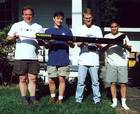 |
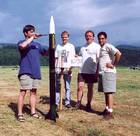 |
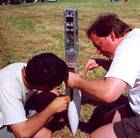 |
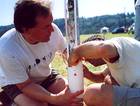 |
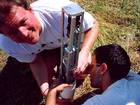 |
 |
 |
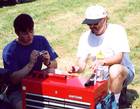 |
 |